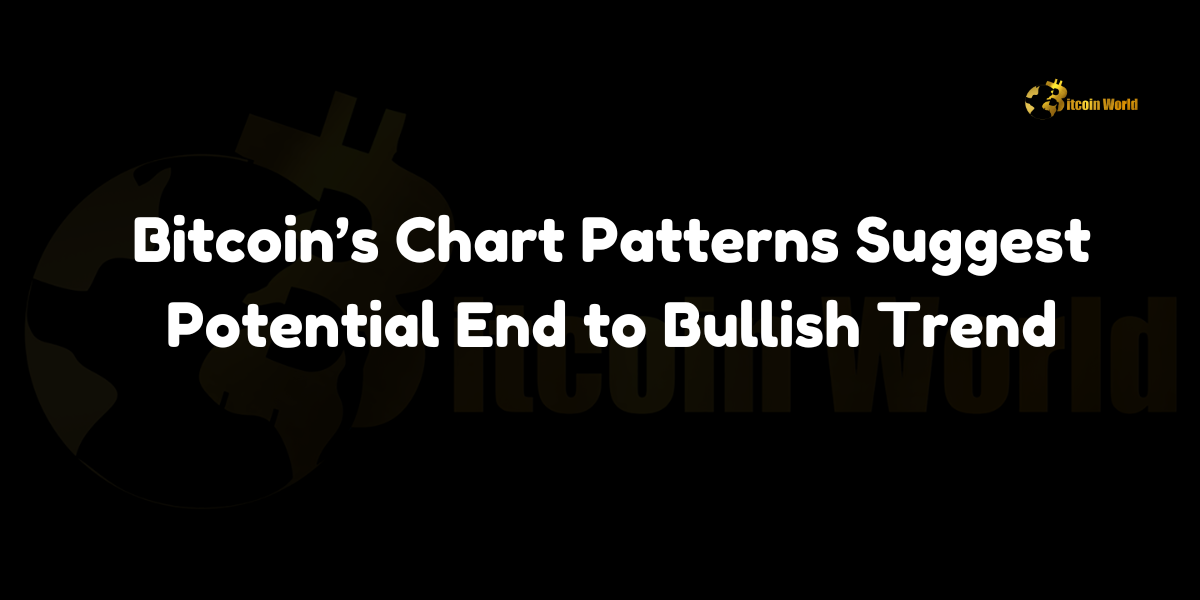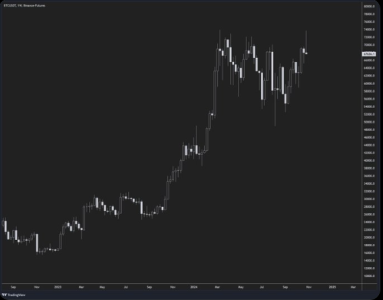Crptocurrency
Bitcoin’s Chart Patterns Suggest Potential End to Bullish Trend

Bitcoin’s Chart Patterns Suggest Potential End to Bullish Trend
In a critical turn for Bitcoin (BTC) enthusiasts and investors, recent chart patterns indicate a possible conclusion to the prevailing bullish trend. According to U.Today, which referenced an X post by the pseudonymous crypto trader Byzantine General, Bitcoin has formed a “gravestone Doji” candlestick on its weekly BTC/USDT chart—a bearish signal often interpreted as a harbinger of trend reversal. This development comes after Bitcoin surged past $73,000, approaching a new all-time high, only to retract to $67,000.

Understanding the Gravestone Doji
What is a Gravestone Doji?
A gravestone Doji is a specific candlestick pattern characterized by a long upper shadow and little to no lower shadow, with the open, low, and close prices being nearly identical at the bottom of the trading range. This formation typically occurs after a significant uptrend and is considered a strong bearish indicator, suggesting that buyers were unable to maintain the upward momentum, potentially signaling a reversal to a downtrend.
Significance in Technical Analysis
In the context of Bitcoin, the appearance of a gravestone Doji on the weekly chart implies that the bullish sentiment may be waning. Traders and analysts often view this pattern as a cautionary signal to prepare for possible price declines or a consolidation phase following the bullish surge.
Recent Price Movements and Indicators
Bitcoin’s Surge and Retraction
Bitcoin recently experienced a substantial price increase, breaching the $73,000 mark and nearing a new all-time high. However, this upward momentum was short-lived, as BTC retracted to $67,000. This significant dip highlights the volatility inherent in cryptocurrency markets and raises questions about the sustainability of the recent bullish trend.
Bollinger Bands Analysis
On the four-hour chart, Bitcoin dipped below the lower Bollinger Band. Bollinger Bands are a technical analysis tool that measures the volatility of an asset and identifies overbought or oversold conditions. When the price falls below the lower band, it often indicates that the asset is oversold and may be due for a price correction or bounce back. In Bitcoin’s case, this dip suggests increasing bearish sentiment and potential downward pressure.
Bullish Divergence on One-Hour Timeframe
Despite the bearish signals, a bullish divergence was observed on the one-hour timeframe. Bullish divergence occurs when the price makes a new low, but the corresponding technical indicator (such as the Relative Strength Index or RSI) forms a higher low. This pattern can signal a potential weakening of bearish momentum and the possibility of a price rebound.
Implications for Bitcoin Investors
Potential End to the Bullish Trend
The convergence of the gravestone Doji formation and Bitcoin’s dip below the lower Bollinger Band presents a compelling case for the potential end of the current bullish trend. Investors may need to reassess their positions, consider taking profits, or implement risk management strategies to mitigate potential losses in the face of rising bearish indicators.
Short-Term vs. Long-Term Outlook
While the bearish signals are concerning, the bullish divergence on the one-hour timeframe introduces an element of uncertainty. This suggests that while short-term bearish momentum may be emerging, there remains the potential for a price stabilization or even a short-term recovery. Long-term investors should weigh these signals against fundamental factors such as Bitcoin’s adoption, regulatory developments, and macroeconomic trends.
Strategic Considerations
Investors might consider the following strategies in light of the current technical indicators:
- Risk Management: Implement stop-loss orders to protect against significant downturns.
- Diversification: Spread investments across different assets to mitigate risks associated with Bitcoin’s volatility.
- Technical Analysis: Continue monitoring key support and resistance levels, along with other technical indicators, to inform trading decisions.
Expert Opinions
Dr. Emily Carter, Blockchain Analyst
“The formation of a gravestone Doji on Bitcoin’s weekly chart is a noteworthy bearish signal. Coupled with the dip below the lower Bollinger Band, it suggests that the market sentiment is shifting. However, the bullish divergence on the one-hour chart indicates that we should remain cautious and not interpret these signals in isolation.”
Mark Thompson, Financial Strategist
“Bitcoin’s recent volatility underscores the importance of technical indicators in guiding investment strategies. The gravestone Doji and Bollinger Bands dip are red flags for potential trend reversal, but the bullish divergence provides a counterbalance. Investors should stay informed and agile in their approach.”
Sarah Lee, Cryptocurrency Researcher
“While bearish patterns like the gravestone Doji can signal a potential end to a bullish trend, it’s essential to consider the broader market context. Factors such as institutional investment, regulatory changes, and global economic conditions will play significant roles in determining Bitcoin’s future trajectory.”
Future Outlook
Monitoring Key Support Levels
Investors should closely monitor Bitcoin’s performance around key support levels, particularly the $68,000 mark identified by analysts. Holding above this level could provide a foundation for a price rebound, while a break below may trigger further declines.
Impact of Federal Reserve Decisions
As the U.S. Federal Reserve approaches its decision on interest rates, scheduled for November 7, monetary policy will play a crucial role in shaping the cryptocurrency market. An easing of monetary policy could inject liquidity into the markets, potentially supporting Bitcoin’s price. Conversely, tightening measures may exacerbate bearish trends.
Technological and Adoption Factors
Beyond technical indicators, Bitcoin’s long-term outlook is influenced by its technological advancements, adoption rates, and competitive positioning within the broader cryptocurrency ecosystem. Continued improvements in scalability, security, and usability will bolster Bitcoin’s appeal and resilience against market fluctuations.
Conclusion
The recent formation of a gravestone Doji on Bitcoin’s weekly chart, combined with a dip below the lower Bollinger Band on the four-hour chart, suggests a potential end to the current bullish trend. While these technical indicators point towards increasing bearish sentiment, the presence of a bullish divergence on the one-hour timeframe introduces a degree of uncertainty. Investors must navigate these signals with a balanced approach, incorporating risk management strategies and staying attuned to broader market and regulatory developments.
As Bitcoin approaches critical support levels and with significant monetary policy decisions imminent, the cryptocurrency’s price dynamics remain highly sensitive. Maintaining a comprehensive understanding of both technical and fundamental factors will be essential for making informed investment decisions in the evolving digital asset landscape.
To stay updated on the latest developments in cryptocurrency market trends and technical analyses, explore our article on latest news, where we cover significant events and their impact on the digital asset ecosystem.
Disclaimer: The information provided is not trading advice, Bitcoinworld.co.in holds no liability for any investments made based on the information provided on this page. We strongly recommend independent research and/or consultation with a qualified professional before making any investment decisions.
Crptocurrency
BTC/Gold Index Sees Biggest Single-Day Surge Since 2022 Following Trump’s Election Win

Crptocurrency
Rekt Raises $1.5M Seed Round Backed by Angels and Community, Following Sell-Out Success of Rekt Drinks

Crptocurrency
JP Morgan Analysts Expect Bitcoin and Gold Gains Under Trump Presidency

JP Morgan Analysts Expect Bitcoin and Gold Gains Under Trump Presidency
JP Morgan analysts, led by Nikolaos Panigirtzoglou, foresee a strong bullish outlook for gold and Bitcoin under President-elect Donald Trump’s administration, driven by what they term a “debasement trade” strategy. This approach aims to profit from anticipated currency devaluation and inflationary pressures, which typically benefit assets viewed as stable stores of value, including gold and Bitcoin. JP Morgan’s analysis suggests that continued demand for exchange-traded funds (ETFs), geopolitical uncertainties, and major Bitcoin acquisitions by companies like MicroStrategy will support this trend through 2025.
Key Drivers Behind JP Morgan’s Bullish Prediction
Several factors underpin JP Morgan’s expectation of gains for Bitcoin and gold in the upcoming years:
- Debasement Trade Strategy: The “debasement trade” benefits from policies that lead to currency devaluation, particularly during periods of expansionary fiscal policies. As the U.S. dollar loses value, investors often turn to hard assets like gold and Bitcoin to preserve purchasing power, positioning them as attractive hedges.
- Geopolitical Tensions and Trade Policies: Trump’s stance on trade tariffs and the possibility of increased geopolitical tensions could lead to further dollar devaluation, adding to the appeal of Bitcoin and gold as alternative assets.
- Rising Demand for Gold and Bitcoin ETFs: The analysts note significant demand for Bitcoin and gold ETFs since mid-2023, driven largely by retail investors. As institutional interest grows, these ETFs provide an accessible means of exposure, bringing fresh capital to both assets.
- MicroStrategy’s Bitcoin Acquisition Plans: MicroStrategy, a major corporate holder of Bitcoin, has announced plans to increase its holdings. This institutional investment, combined with favorable economic conditions, is expected to create upward pressure on Bitcoin’s price, signaling confidence among large-scale investors.
The Role of Gold and Bitcoin as Inflation Hedges
Both gold and Bitcoin are widely recognized as stores of value that can serve as inflation hedges. In periods of high inflation or economic uncertainty, investors tend to favor assets that are not directly tied to fiat currencies, making gold and Bitcoin particularly attractive. Here’s how each asset fulfills this role:
- Gold: Historically, gold has been a go-to asset during periods of inflation and currency devaluation. Its tangible, finite supply makes it a safe haven in times of economic instability, offering stability when other assets might be declining in value.
- Bitcoin: While relatively new, Bitcoin’s limited supply of 21 million coins positions it as a “digital gold” with deflationary characteristics. Investors increasingly view Bitcoin as an inflation hedge, especially as regulatory clarity and institutional interest grow.
How Trump’s Economic Policies Could Boost Gold and Bitcoin
Under Trump’s administration, certain economic policies could amplify demand for Bitcoin and gold. Here’s what JP Morgan analysts highlight as key areas of influence:
- Expansionary Fiscal Policies: Trump’s prior administration implemented tax cuts and expansionary measures that drove economic growth but also increased federal debt. If similar policies are enacted, they could result in inflationary pressures, driving up demand for assets like gold and Bitcoin as stores of value.
- Increased Tariffs and Geopolitical Uncertainty: Trade policies, particularly tariffs, can lead to currency instability. Bitcoin and gold could benefit as investors seek out assets with less exposure to fiat currency fluctuations and trade uncertainties.
- Support for Financial Innovation: Trump has previously expressed interest in fostering innovation within the financial sector, which may include support for cryptocurrency regulation. A regulatory environment that favors digital assets could encourage institutional investment, further supporting Bitcoin’s price growth.
Growing ETF Demand Signals Institutional Interest
The report also highlights the impact of ETF demand on Bitcoin and gold prices. The introduction of ETFs for both assets has allowed a broader range of investors to participate in these markets, bringing liquidity and stability. Key points include:
- Retail Investor Demand: Since mid-2023, retail interest in ETFs has surged, particularly for Bitcoin ETFs. These products provide convenient and regulated access to Bitcoin, fueling demand and adding stability to its market.
- Institutional Adoption of Bitcoin ETFs: With major players like BlackRock and Fidelity entering the Bitcoin ETF market, institutional adoption is likely to increase, encouraging further investments. ETFs lower the entry barrier for large investors and hedge funds, contributing to Bitcoin’s mainstream acceptance.
MicroStrategy’s Bitcoin Strategy and Institutional Confidence
MicroStrategy has been one of the most vocal institutional supporters of Bitcoin, holding significant amounts of BTC on its balance sheet. The company’s plans for continued Bitcoin acquisitions reflect a broader trend of institutional confidence in Bitcoin as an asset class:
- Corporate Bitcoin Holdings: By increasing its Bitcoin reserves, MicroStrategy is signaling confidence in Bitcoin’s long-term value, potentially inspiring other companies to follow suit. This institutional buy-in could stabilize Bitcoin’s price and encourage broader adoption.
- Market Influence: MicroStrategy’s Bitcoin holdings influence market sentiment, as its public commitment to Bitcoin boosts investor confidence and supports a long-term bullish outlook.
Risks to JP Morgan’s Prediction
While JP Morgan’s outlook is optimistic, analysts have identified potential risks that could impact Bitcoin and gold’s performance:
- Regulatory Changes: Shifts in U.S. regulatory policy, particularly around digital assets, could introduce volatility to Bitcoin’s price. Strict regulations could dampen institutional participation and ETF demand, slowing Bitcoin’s growth.
- Economic Policy Reversals: If Trump’s administration implements policies that strengthen the dollar, such as reducing tariffs or prioritizing economic stability, the demand for Bitcoin and gold as inflation hedges may decrease.
- Market Volatility: Bitcoin’s inherent volatility remains a consideration for investors. Market corrections could impact short-term performance, even with strong long-term fundamentals.
Conclusion
JP Morgan’s analysis underscores a favorable outlook for Bitcoin and gold under Trump’s presidency, with expectations that inflationary policies, rising ETF demand, and strategic acquisitions by firms like MicroStrategy will drive these assets’ growth. The “debasement trade” strategy, geared toward profiting from currency devaluation, supports this trend by encouraging investment in assets seen as stores of value during economic uncertainty.
If these factors align, Bitcoin and gold could experience significant gains in the coming years, with Bitcoin’s expanding role as a digital store of value potentially setting new price benchmarks. For investors, this forecast highlights the strategic value of these assets within a diversified portfolio, particularly as the economy navigates potential inflation and currency pressures.
For further insights on Bitcoin, gold, and inflationary trends, explore our latest market analysis on investment strategies and asset performance under shifting economic policies.
Disclaimer: The information provided is not trading advice, Bitcoinworld.co.in holds no liability for any investments made based on the information provided on this page. We strongly recommend independent research and/or consultation with a qualified professional before making any investment decisions.
-

 Startup Stories1 year ago
Startup Stories1 year agoWhy Millennials, GenZs Are Riding The Investment Tech Wave In India
-

 Startup Stories1 year ago
Startup Stories1 year agoStartups That Caught Our Eyes In September 2023
-

 Startup Stories1 year ago
Startup Stories1 year agoHow Raaho Is Using Tech To Transform India’s Fragmented Commercial Trucking
-

 Startup Stories12 months ago
Startup Stories12 months agoMeet The 10 Indian Startup Gems In The Indian Jewellery Industry’s Crown
-

 Crptocurrency8 months ago
Crptocurrency8 months agoLither is Making Crypto Safe, Fun, and Profitable for Everyone!
-

 Startup Stories1 year ago
Startup Stories1 year agoHow Volt Money Is Unlocking The Value Of Mutual Funds With Secured Lending
-

 Startup Stories1 year ago
Startup Stories1 year agoWhy Moscow-Based Kladana Considers Indian SME Sector As The Next Big Market For Cloud Computing
-

 E-commerce1 year ago
E-commerce1 year agoTop Online Couponing Trends To Watch Out For In 2016




